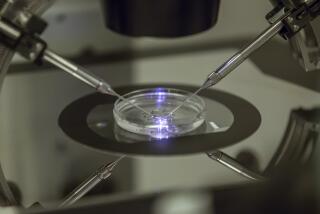Op-Ed: Bad press about genetic engineering could scare off those who would benefit most

When the reports came out last year that a Chinese scientist had altered the genome of human twins in utero, scientists and ethicists around the world were rightly horrified.
The experiment was denounced as wildly unsafe, medically unnecessary and a clear moral violation. Tinkering with the DNA of embryonic cells (some of which will develop into reproductive cells capable of passing the mutation on to future generations) is roundly condemned, and the idea of designing babies to order raises a host of ethical dilemmas.
But the bigger tragedy will be if the glaring lack of judgement shown by one overly ambitious (and improperly mentored) scientist taints all research into the gene-altering method used in the experiments, which is relatively simple and hugely promising. The technique, known as CRISPR, has the potential to alter genes in a way that is ethical and could offer hope to people with diseases that currently have few treatment options.
We shouldn’t let a huge lapse in Chinese research taint an entire field.
One of the most promising areas for the technique involves sickle cell anemia, an inherited disease that affects 100,000 Americans, a large proportion of them of African descent. Caused by abnormal sickle-shaped blood cells that clump and clog small blood vessels, the condition cuts life expectancy nearly in half, and leaves survivors with strokes, organ damage and pain crises so severe, they often require hospitalization.
Because the disorder is caused by a single mutation in a single gene, sickle cell disease has long been seen as an obvious target for genetic engineering, and CRISR is considered a likely method to use. The technique employs specialized stretches of DNA that work like molecular scissors to snip out precise portions of DNA, like those with the mutations that cause sickle cell, and replace them with other genes.
Several biotech startups have already begun testing treatments using CRISPR and other genetic editing techniques to treat sickle cell disease. They use different approaches, aiming to re-engineer a patient’s own blood stem cells so they produce rounder blood cells, or alter genes so patients produce more of a form of oxygen-transporting protein hemoglobin that’s less likely to cause problems. While still in the early days, some clinical trials are showing promising and safe results. And because the techniques are aimed at cells that aren’t part of the reproductive system, there is no danger of the genetic alterations being passed on to future generations.
A major problem, though, is that many black patients are deeply skeptical about these largely untested therapies. That’s not surprising, given the long and painful history African Americans have experienced with modern medical experiments. Most egregious were the Tuskegee experiments, in which U.S. Public Health Service personnel deliberately left the syphilis of black men untreated for decades. Scientists still refer to the low enrollment by black volunteers in clinical trials as “Tuskegee syndrome.” In another high-profile failure of trust, one of the most important cell lines used in medical research today, HeLa, was created from cells taken from a dying black woman, Henrietta Lacks, without her permission; scientists later stripped the family of privacy by publicly revealing Lacks’ identity.
Many sickle cell patients and their physicians say they continue to see evidence of widespread medical racism that makes them leery. Black sickle cell patients say they are often turned away from emergency rooms as “drug seekers” when seeking help for the excruciating pain they endure when their muscles don’t receive enough oxygen. Despite the fact that 100,000 people suffer from sickle cell, there are only two FDA-approved drugs available. Contrast that with hemophilia, which afflicts about 20,000 people — mostly white men — and for which there are more than two dozen approved drugs. For sickle cell disease, new therapies are sorely needed.
Enter the Fray: First takes on the news of the minute »
Black patients are understandably reluctant to roll up their sleeves for an experimental treatment offered by a medical establishment that has served them so poorly in the past. And the terrible headlines about China’s new CRISPR babies have fed existing fears about poor ethics and oversight in medical research.
But the crisis of sickle cell anemia is so deep and painful that some black community leaders — coming from churches, health organizations and far too many funerals of young sickle cell patients — are encouraging change. Religious leaders are forming unlikely alliances with genetic researchers to encourage people of color to be open to these new therapies and consider participating in the clinical trials needed to test them.
We need to ensure that the highest ethical standards are employed in developing experimental treatments, including genetic treatments for sickle cell. But we shouldn’t let a huge lapse in Chinese research taint an entire field.
If a potent 21st century technology can finally put a stop to a devastating illness that claims far too many people in their prime, it should be offered as soon as it’s proved to be safe. It’s fitting that one of the biomedical industry’s newest, hottest and most exciting therapies could go first to a population that that same industry has mistreated or ignored for far too long.
Usha Lee McFarling, a former science writer at the Los Angeles Times, won a Pulitzer Prize for explanatory journalism in 2007.
More to Read
A cure for the common opinion
Get thought-provoking perspectives with our weekly newsletter.
You may occasionally receive promotional content from the Los Angeles Times.










